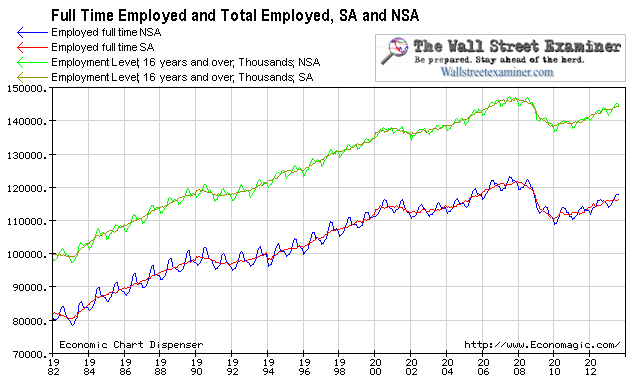by Lee Adler
In Part 1 of this report we looked at non-farm payrolls, which come from the BLS the Current Employment Statistics Survey or CES, a survey of business establishments. The BLS also does a survey of households. The household survey or CPS — Current Population Survey– sometimes tells a different story from the establishment survey. It’s also important in that it breaks out full time employment from total employment so that we can analyze that important metric separately.
The actual NSA (not seasonally adjusted) number of persons reported in the CPS as employed in May rose by 708,000 from April. Over the previous 10 years, with the exception of 2009, May has always shown an increase. The average increase over that period, excluding the recession year of 2009 was 445,000. Last year the increase was 732,000. This year’s May gain was second to only last year over the past 11 years.
The year over year gain in total employment under the CPS was 1.2% which was the same as in April and up from 0.9% in March. The annual growth rate has decelerated from 2.2% last October. The growth rates were actually stronger before the Fed restarted pumping money into the economy in November, when it settled its first MBS purchases in QE3.
Full time employment in the CPS rose by 969,000 in May, which is always an up month for full time jobs. This year’s gain was better than last year’s 635,000 and better than the average gain of 756,000. The annual gain was 1.8%, which is better than a trough of 0.8% set in March, but still below the 2.4% rate when QE3 was announced in September and 2.1% when the cash started hitting the system in November.
As for whether the fecal cliff and secastration have had a negative impact, the answer is no. The current annual gain of 1.8% in full time jobs is exactly the same as in December and January before the fecal cliff took effect. The Keynesian complaint that the fecal cliff has slowed jobs growth isn’t supported by the data. It also does not appear that the Obamacare employment rules that require full time workers to have coverage has had a lasting material impact. The hysteria and paranoia surrounding government policy notwithstanding, the US economy is so big and slow moving that these niggling policy changes at the margin have virtually no impact.
The chart above gives some perspective on how far total employment and full time employment fell in the first stage of the 2008-09 depression, and how much they have yet to recover.
With QE3 in late 2012, the Fed began adding more fuel to an engine that was running at its natural capacity. Job growth has not accelerated in response to the flood of money printing. While house prices and stock prices are rapidly inflating thanks to too many dollars chasing too few assets, job growth has been tepid. The Fed is blowing massive asset bubbles while the economy plods along at the a growth rate little different from when it was in a long pause in QE in 2011 and 2012. Money printing works to inflate asset prices, but it does nothing to stimulate job growth.
The chart below shows that while the number of jobs is growing, the full time employment to population ratio has barely budged since the recovery began in 2009. The economy seems to barely be keeping pace with population growth. The full time employment to population ratio bottomed at 46% in January 2010, and it’s at 47.5% today. That compares with 47.1% a year ago. While there’s been some year to year improvement in the past 12 months, this ratio is still at levels last seen in 1982 and 1983 at the bottom of a horrible recession.
The number of unemployed persons is growing right along with the number of people who do have jobs. It is a sad state of affairs for the US, but markets don’t care about that. They respond to the amount of cash in securities dealer accounts, which, thanks to the Fed (and lately the BoJ), continues to grow. As long as the Fed continues to pump money into the markets, I doubt that slow employment growth will matter much. In fact, most will see it as an excuse for the Fed to continue blowing a bubble.




No comments:
Post a Comment